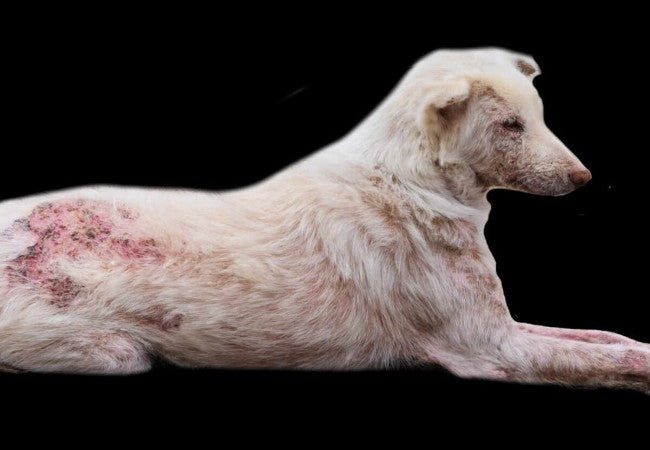Vet’s 2025 Guide to Mange in Dogs 🩺🐾

In this article
Vet’s 2025 Guide to Mange in Dogs 🩺🐾
By Dr. Duncan Houston BVSc
Mange refers to a skin disease caused by parasitic mites. The two main types in dogs are demodectic mange (Demodex mites) and sarcoptic mange (Sarcoptes scabiei). They vary in severity, contagion risk, and treatment, but both demand careful diagnosis and therapy. This guide dives into causes, signs, diagnostics, cutting-edge treatments available in 2025, and supportive care—including telehealth and comfort tools from Ask A Vet.
1️⃣ Types of Mange
Demodectic Mange (Red Mange)
- Caused by the overgrowth of Demodex canis, normal skin mite; not contagious to people.
- Localized form in puppies often resolves on its own; generalized form requires full treatment.
- Occurs when immune regulation fails—often secondary to stress, genetics, or illness.
Sarcoptic Mange (Scabies)
- Caused by Sarcoptes scabiei mites burrowing into skin and causing intense itching.
- Highly contagious between dogs—and sometimes to humans, causing transient itching.
- Typically affects elbows, ears, and abdomen, and may spread rapidly.
2️⃣ Recognizing the Signs
Demodectic Mange
- Patchy hair loss, especially on face, paws, trunk; often no itch at first.
- With progression, red, scaly, thickened lesions and bacterial infections may occur.
Sarcoptic Mange
- Intense scratching, red papules, and crusty skin, particularly at elbows, ears, and abdomen.
- Possible self-trauma lesions and bacterial/yeast infections.
3️⃣ How Mange Is Diagnosed
- Skin scrapings: deep scrapings for Demodex; easier to detect Sarcoptes via symptoms (“pedal-pinna reflex”).
- Microscope exam: confirms mites and guides treatment.
- Cytology/cultures: assess secondary infections.
4️⃣ Modern Treatment Options
Demodectic Mange
- Isoxazoline chews (fluralaner, afoxolaner, sarolaner) shown to be effective for generalised demodicosis.
- Doramectin injections weekly are a safe and effective option.
- Topical miticides: moxidectin + imidacloprid, benzoyl peroxide dips, amitraz dips, off-label ivermectin/milbemycin.
- Treat until two consecutive negative scrapings per Plumb’s Manual (4–6 weeks apart).
Sarcoptic Mange
- Macrocyclic lactones: selamectin spot-on or oral ivermectin—but avoid ivermectin in MDR1 breeds.
- Afoxolaner and milbemycin combos: chewables (e.g., NexGard, NexGard Spectra) offer rapid relief.
- Topical therapy: medicated shampoos, dips, baths before systemic treatment.
- Treat for at least 4–6 weeks to cover the mite life cycle and prevent relapse.
5️⃣ Supporting Skin Health & Comfort
- Antibiotics and anti-itch meds for secondary infections and relief.
- Regular medicated baths and topical care improve skin integrity.
- Supportive measures: omega-3, vitamin E for skin healing.
- Use Ask A Vet telehealth for monitoring treatment status and dealing with breed sensitivities.
6️⃣ Prevention & Monitoring
- Prompt vet check for early hair loss or itch to avoid spread.
- Avoid breeding dogs with generalized demodicosis.
- Maintain flea/tick control—some mite therapies overlap.
- Clean bedding and living areas; isolate infected pets during sarcoptic treatment.
7️⃣ When to Call the Vet Immediately
- Rapid hair loss, intense itching, skin lesions, or infection.
- Breed-specific risks (e.g. MDR1 quirks, sensitive breeds).
- Lack of improvement after several weeks of therapy.
- Signs of systemic illness or severe secondary infections.
🏁 Final Thoughts
Mange can be challenging—but with accurate diagnosis, modern treatments, and pet-specific care, most dogs recover fully by 2025. Regular monitoring, telehealth support, and enriching recovery environments via Ask A Vet, Stay attentive and treat early for the best outcomes. 🐶❤️
Need help selecting the right therapy, monitoring progress, or understanding breed sensitivities? Visit AskAVet.com and download the Ask A Vet app for personalized support anytime. 📱🐾






